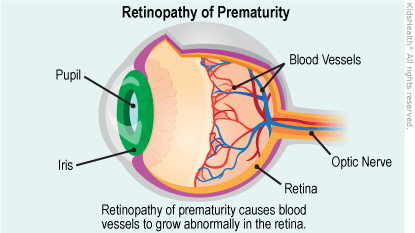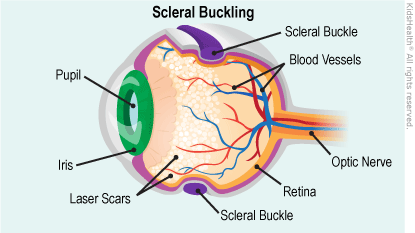- Parents Home
- Para Padres
- A to Z Dictionary
- Allergy Center
- Asthma
- Cancer
- Diabetes
- Diseases & Conditions
- Doctors & Hospitals
- Emotions & Behavior
- First Aid & Safety
- Flu (Influenza)
- Food Allergies
- General Health
- Growth & Development
- Heart Health & Conditions
- Homework Help Center
- Infections
- Newborn Care
- Nutrition & Fitness
- Play & Learn
- Pregnancy Center
- Preventing Premature Birth
- Q&A
- School & Family Life
- Sports Medicine
- Teens Home
- Para Adolescentes
- Asthma
- Be Your Best Self
- Body & Skin Care
- Cancer
- Diabetes
- Diseases & Conditions
- Drugs & Alcohol
- Flu (Influenza)
- Homework Help
- Infections
- Managing Your Weight
- Medical Care 101
- Mental Health
- Nutrition & Fitness
- Q&A
- Safety & First Aid
- School, Jobs, & Friends
- Sexual Health
- Sports Medicine
- Stress & Coping
Retinopathy of Prematurity (ROP)
What Is Retinopathy of Prematurity?
Retinopathy of prematurity (ROP) is an eye disease that can happen in premature babies. It causes abnormal blood vessels to grow in the retina, and can lead to blindness.
What Happens in Retinopathy of Prematurity?
Retinopathy (ret-in-AH-puh-thee) of prematurity makes blood vessels grow abnormally in the eye that can leak or bleed. This causes scarring of the retina, the layer of nerve tissue in the eye that sends messages about light to the brain.

When the scars shrink, they can pull on the retina, detaching it from the back of the eye. In severe cases, this leads to vision loss and even blindness.

What Causes Retinopathy of Prematurity?
While in the womb, a baby’s retinal blood vessels begin to grow at 16 weeks and don’t finish growing until after the baby is born. So an early birth can disrupt this growth or cause abnormal growth. Babies born earlier than 31 weeks of gestation, or who weigh less than 1500 grams at birth, are most at risk.
ROP has no signs or symptoms when it first develops in a newborn. The only way to diagnose it is through an eye exam by an .
How Is Retinopathy of Prematurity Treated?
Some cases of ROP are mild and correct themselves. But others are severe enough to cause scarring that can pull the retina away from the rest of the eye. These cases need surgery to prevent vision loss or blindness.
ROP surgery stops the growth of abnormal blood vessels. Treatment focuses on the peripheral retina (the sides of the retina) to preserve the central retina (the most important part of the retina). ROP surgery involves scarring areas on the peripheral retina to stop the abnormal growth and eliminate pulling on the retina.
Because surgery focuses on the peripheral retina, some amount of peripheral vision may be lost. But preserving the central retina means the eye can still let a child do important things like see straight ahead, tell colors apart, read, etc.
Surgery
The most common methods of ROP surgery are:
- laser surgery (laser therapy or photocoagulation): This is done most often for ROP. Small laser beams scar the peripheral retina.
- injection: A medicine is injected into the eye. This might be done as an alternative to, or along with, laser surgery. This is a newer treatment and results are promising, often allowing the blood vessels to grow more normally. Research is ongoing to determine the long-term side effects of the medicine on premature infants.
For advanced cases of ROP with retinal detachment, these methods are used:
- scleral buckling: This involves placing a flexible band, usually made of silicone, around the whole eye. The band goes around the sclera, or the white of the eye, causing it to push in, or "buckle." This, in turn, pushes the detached retina closer to the outer wall of the eye.

- vitrectomy: This surgery replaces the clear gel in the center of the eye (called the vitreous) with a saline (salt) solution. This makes it easier for the surgeon to remove scar tissue and eases tugging on the retina, which stops it from pulling away.
What Happens in Retinopathy of Prematurity Surgery?
Your baby's ophthalmologist will talk with you about which ROP surgery method is best.
ROP surgery is usually done with a child under either general anesthesia (medicine that causes a deep sleep-like state) or sedation (the child is unaware of the procedure, but isn't as deeply sedated as with general anesthesia). Some procedures can be done right at a child’s hospital bedside (like laser surgery), while others need to be done in an operating room.
To start, doctors give a baby eye drops to dilate the pupil(s) before the procedure. During the surgery, a tool called an eyelid speculum is gently inserted under the eyelids to keep them from closing. The baby's breathing and heart rate are closely monitored.
The eye will be covered with a patch after scleral buckling and vitrectomy, but not after laser surgery or an injection. Whether a hospital stay is needed depends on the child's medical condition and age at the time of surgery.
If a hospital stay isn't needed, you can take your child home about an hour after the procedure. You’ll need to give eye drops to prevent infection and/or inflammation for at least a week.
To make sure your baby's eyes heal properly and that ROP hasn't returned, go to all follow-up eye exams. These usually happen every 1–2 weeks. For scleral buckling, the ophthalmologist must examine the buckle every 6 months to account for a child's growing eye.
What Else Should I Know?
The goal of ROP surgery is to stop the disease from getting worse and prevent blindness. ROP surgery has a good success rate, but not all babies respond to treatment. Some babies who have ROP surgery might still lose some or all vision.
With ROP surgery, some peripheral (side) vision may be lost. And even if the ROP stops progressing, vision still can be affected. Because some vision loss and other eye problems can happen, any child who has had ROP should have regular, yearly eye exams well into adulthood.

© 1995- The Nemours Foundation. KidsHealth® is a registered trademark of The Nemours Foundation. All rights reserved.
Images sourced by The Nemours Foundation and Getty Images.